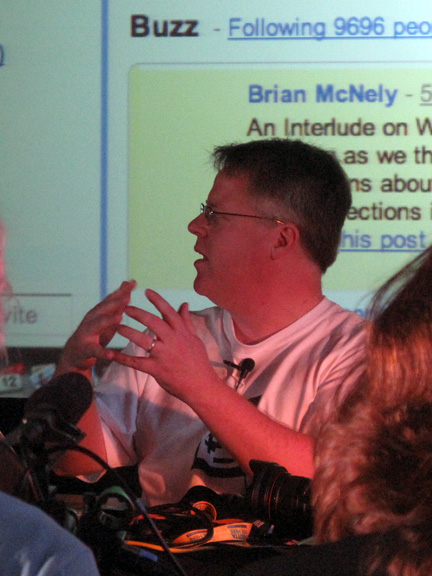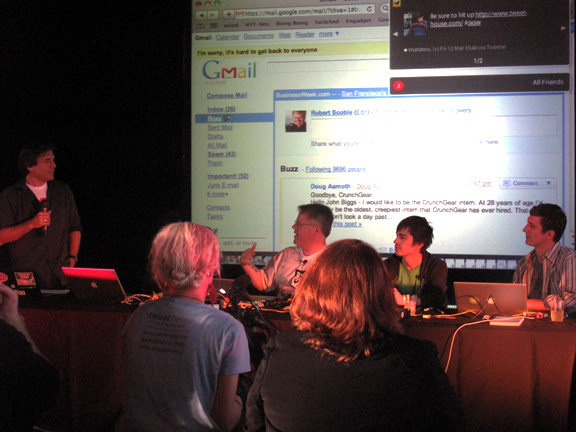The Tweet House, produced by The Parnassus Group and Chevrolet, was an additional series of panels and events held at Mellow Johnny’s bike shop on Nueces, a few blocks from the main action at the convention center. I dropped by for the afternoon panel with Jim Louderback – CEO of Revision 3, Dom Sagolla – co-creator of Twitter, Robert Scoble – influential tech blogger and Rackspace employee, Mark Milian – LA Times tech writer and Brian Wong of Digg. The topic was Tools and Trends: Innovations in The Real-Time Web, and it provided fascinating insight into what these people thought were the most captivating.
 Starting out, they discussed Google Buzz, the micro-blogging, message service associated with Gmail. Scoble has been touting it and discussed it’s benefits, pointing out that there is still much to be revealed by Google regarding the potential of this service. The other panelists were unsure of its additional benefit beyond what we already receive from Twitter, Facebook or some of the location-based services, and like myself, view it’s main audience as those who use Gmail predominantly.
Starting out, they discussed Google Buzz, the micro-blogging, message service associated with Gmail. Scoble has been touting it and discussed it’s benefits, pointing out that there is still much to be revealed by Google regarding the potential of this service. The other panelists were unsure of its additional benefit beyond what we already receive from Twitter, Facebook or some of the location-based services, and like myself, view it’s main audience as those who use Gmail predominantly.
Next, they discussed the concept of augmented reality or the ability to look at details of things while you are walking around, have a layer of information that is placed over objects via looking through your mobile device. It relies on users to provide this layer of information. The consensus was that the more people adopting the platform, the more useful it will become.
It was anticipated that the location-based services like Foursquare and Gowalla would be a hot topic at SXSW. Many on the panel felt that using those services was merely just bragging about what you were doing. Scoble said that attitude misses 2/3 of the usefulness of location services, referencing user-submitted tips and sponsored promotions as relevant applications. The other panelists discussed the potential for users to game the system, to make false check-ins or to provide erroneous tips. This is something that I have wondered about, how organizations hosting location-based promotions might handle.
I liked Sagolla’s description of his use of Twitter, describing it as personal fiction. Like most communications online, we are telling a story, making our everyday life into an adventure. He said to provide some level of entertainment that is removed from reality. Find epic ways to describe your day-to-day activities.
They offered a few links of companies or services to watch, including the location-based aggregator Vicarious.ly and the Cadmus, a service that compiles the trends in your friends social networking streams. I think that aggregation services will continue to be developed, as our social media usage becomes more complex and will need to work together.
So, exactly how much information are we willing to share? Will it ultimately include health or financial information? Scoble said it could, if you have control and can get something back from it, a perceived benefit. A service from Google, Blue Dot, will tell you where in local area you may find something in stock that you would like to purchase.
And finally, Louderback asked the panel to talk about features that did not exist on location-based services that they wished they had. Scoble mentioned the need for curation. Milian said he wanted to understand friends’ trends and to have tools that would making sense of junk he gets in his social networking streams. Sagolla said Twitter was working on some features to allow targeting of messages to a subset of followers, a certain type of person by creating what he called bi-directional groups. And Wong expressed what we all wanted, “peacefulness and calm,” which, I think, was another way to express the need for control, having filters and lists that shows us what we care about -again, the need for aggregation.
I always like to come out of SXSW with some big idea takeaways, and this panel has already given me a good idea of the direction of things to come.

